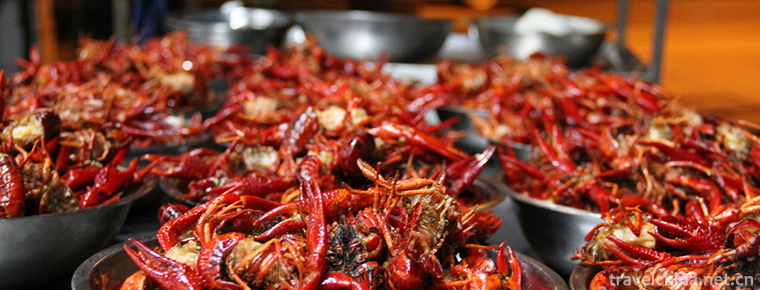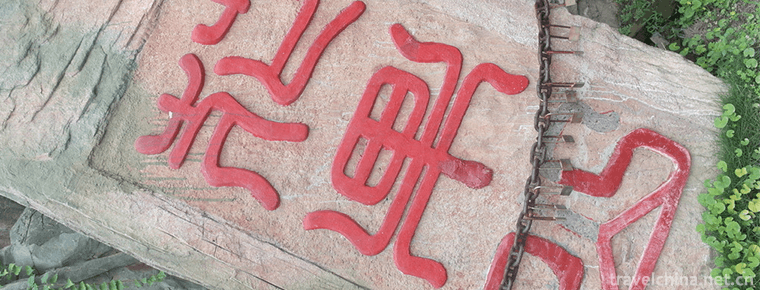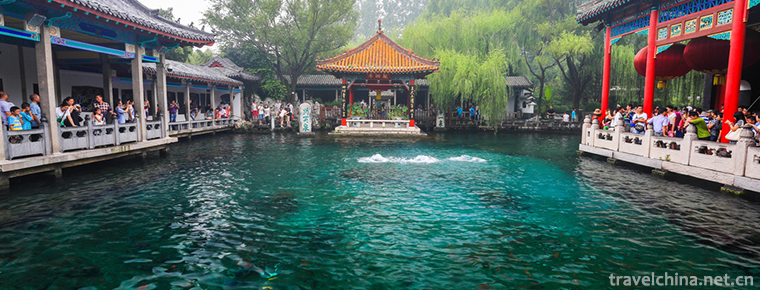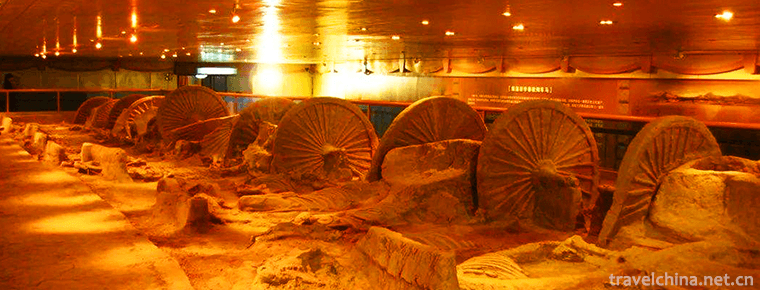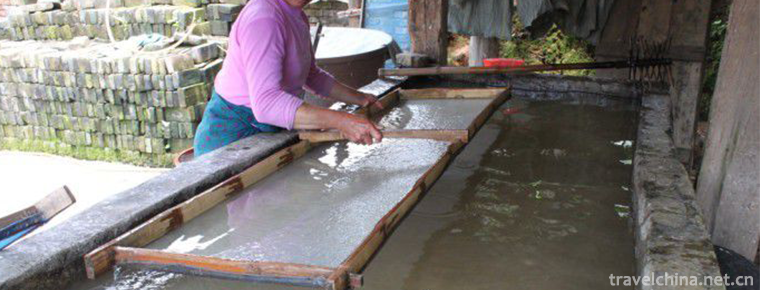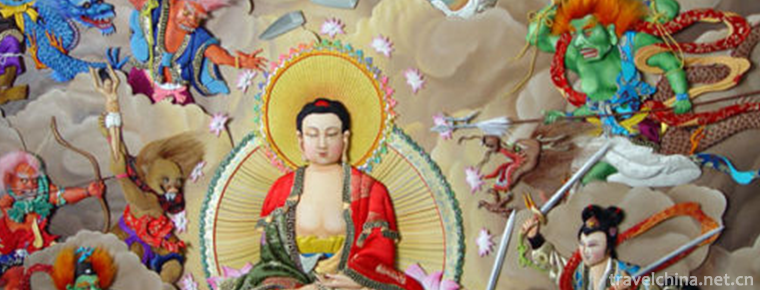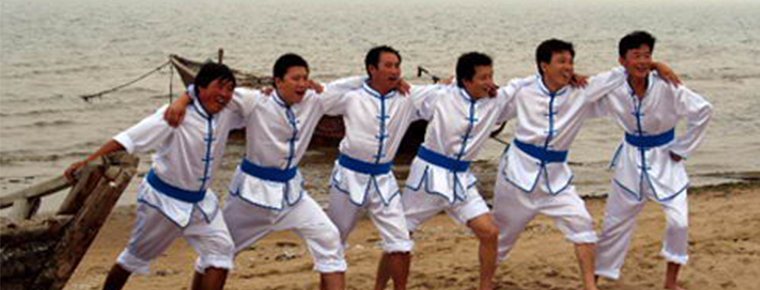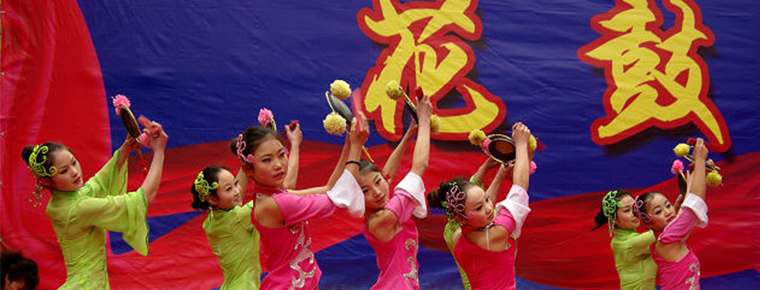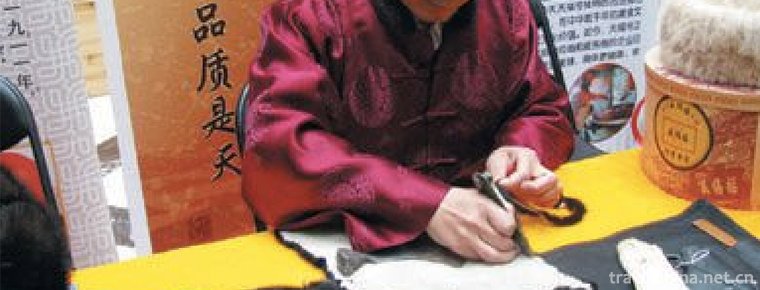The Grand View Garden Area of Shanghai
Shanghai Grand View Garden is located at 701 Qingshang Highway, Qingpu District, Shanghai. It is situated on the west side of Dianshan Lake, 65 kilometers away from downtown Shanghai. It covers an area of 135 Mu and covers an area of about 8000 square meters. Originally known as Dianshan Lake Scenic Tourist Area, it was renamed Shanghai Grand View Garden in 1991, covering an area of 1500 mu. It is a key unit in the construction of spiritual civilization in Shanghai. After many renovations and expansion, it is a comprehensive amusement park with sightseeing, tourism and leisure.
Shanghai Grand View Garden is a large-scale antique garden designed according to the description of the famous Qing Dynasty work A Dream of Red Mansions. Landscape buildings are planned and designed by Liang Yousong of Shanghai Garden Academy. The overall layout takes the Grand View Building as the main body. The central axis of the whole park is formed by the stone archway, stone lanterns, Qinfang Lake, body benevolence Mude, winding paths, Palace gates, relief photo walls and wooden archways of the "Provincial Pro Villas". On the West side, there are Yihong Hospital, Yucui Temple, Lixiangyuan and Shihuang. On the East side, there are more than 20 architectural attractions such as Xiaoxiang Pavilion, Huowu Court, Polygonum Fengxuan and Daoxiang Village.
Shanghai Grand View Garden has won the Luban Prize for National Architecture, the 10th Best Building for the 40th Anniversary of Shanghai, the 10th Best New Leisure Scenic Spot, the 50th Anniversary of New China, the 10th Top Ten Tourist Landscapes, the Seven Great Civilization Parks of Shanghai and the Advanced Collective Scenic Spots of the National Ministry of Construction.
Historical evolution
In 1958, the Shanghai Municipal Garden Administration Department established nurseries in Dianfeng and Xicen on the Hunan shore of Dianshan. Due to national economic difficulties, nurseries were abolished and land was returned to agriculture in 1961-1962.
On October 23, 1978, the Shanghai Municipal Landscape Administration put forward a plan for the construction of Dianshan Lake Scenic Spot. On the same month, Peng Chongdi, the third secretary of the Shanghai Municipal Committee, made a field survey and decided to locate it in Yangshe. On November 17, the same year, with the approval of the Municipal Planning Committee, it agreed to plan comprehensively and build by stages so as to gradually build a relatively complete scenic spot for sightseeing. In the first phase, Guanwangmiao and Yangshe tourist districts were built in advance.
Since January 1979, the Dianfeng Brigade and Yangshe Brigade on the lakeside of Dianshan Lake have been requisitioned in two phases. The first phase is 308.2 million square meters, and the second phase is 593.2 million square meters, totaling 901.4 million square meters. All land requisitions were completed on December 27, 1979.
Beginning in early 1980, the construction of greening and road, bridge and culvert, revetment and other basic projects began. In order to support the construction of Grand View Garden in Shanghai, the relevant departments of Beijing allocated the stone lion to Shanghai. In the second half of 1981, the "Yihong Court" was first built in May 1984 and opened to visitors on the 27th. Subsequently, while building, we opened up. The Qingshang Highway and Baishiji Bridge within the scope of the tourist area were reconstructed by the Municipal Engineering Bureau in 1986.
Daguanyuan Archaic Architecture Complex was completed on October 15, 1988 after seven years of construction. The whole area was opened to the outside world on October 20, 1988. It was first named Dianshan Lake Scenic Area in Shanghai. In January, 1985, it was renamed Dianshan Lake Grand View Park Tourist Area in Shanghai. In 1991, it was named Shanghai Grand View Park.
Design layout
The design of Grand View Garden is obviously different from that of Beijing Grand View Garden in that Shanghai Grand View Garden has laid out a large area of artificial lakes in the park by utilizing the characteristics of Jiangnan Watertown. Taking the gate-Tirenmude-Grand View Tower as the central axis, there are more than 10 buildings and more than 20 scenic spots with a total construction area of 7837 square meters. Designing the winding and secluded big rockery as the entrance barrier, taking digging the lake for soil and dumping up a 16-meter-high hill as the background of the grand view building, constituting the magnificent momentum of the mountain water behind the grand view building. The whole park is centered on the Great Lakes, with ponds and Qinfangxi communicating with each scenic spot, constituting a main and branch, dynamic and static water system, pavilions and pavilions along the lakeside, curved bridges, stone bunkers and stone lanterns in the lake, and bridges and pavilions on the stream, forming a landscape of Jiangnan Garden with heavy mountains and rivers and flowing families. The Grand View Garden uses the traditional architectural concept of "the garden must be sealed and separated" to seek momentum flow and cohesion center in the enclosure. It builds a small enclosed and centripetal world with rich connotations, increases the level of scenery, integrates architecture and environment, and makes the Grand View Garden landscape in A Dream of Red Mansions reappear.
Main attractions
Gate Plaza
In front of the square stands an archway 8 meters high and hangs a plaque of "too illusory land". In front of the main entrance square of the Grand View Garden, the large illumination wall is 18 meters wide and 6 meters high. To the south is the granite carving Nuwa Butian, and to the north is the marble carving "Twelve Chains of Jinling" and 14 portraits of the vigilant fairy and Jia Baoyu. The main entrance is a five-compartment courtyard with three entrances and exits. There is a golden plaque of "Grand View Garden" hanging on it, and a pair of blue stone lions 2.5 meters high in front of the door during the reign of Qianlong in the Qing Dynasty. In the entrance courtyard are vermilion gates and beams and columns, golden copper door rings, brick carvings hanging, fine craftsmanship. There are also two side doors beside them, with brick carved plaques on the top, Ninghui Zhongrui on the East and Wanxiang Zhenghui on the west.
The illusion of Tai Xu
Taifantasy is the second scenic spot of the Grand View Garden. It is an archway about 8 meters high with three single eaves. The pillar base is the Xumi pedestal carved with lotus flowers, and above it is the arch with the characteristics of ancient Chinese wooden structure. Over the archway, there are four big characters in the middle of the book "too illusory". "Too empty" means the sky; "fantasy" means the fantasy fairyland.
Nu Wa remains
Nuwa relic is a huge wall with a width of 18 meters and a height of 10 meters. In the middle of the wall is the granite relief, and on both sides is the green brick wing wall. It plays a role of foil and barrier in the garden. The words carved on the wall have a wonderful finishing touch. The huge granite relief in the middle of Benzhaobi consists of four groups of pictures, which highly summarizes the birth process of the story of A Dream of Red Mansions.
The top level of the wall, named "Nuwa Butian", is the sleeping image of Nuwa. Her hair turned into a river, her body into a mountain, like the deified mother of the earth; on her left was Yuchan, Python entangled with stars, and on her right was the sun left by her descendants when they shot the sun.
Beautiful and fragrant
On the back is the large white jade relief of the Han Dynasty, the twelve champions of Jinling. In the middle of the relief picture is the alarm fairy, holding the book of poor fate in one hand and lifting it slightly in the other, pointing to the Daiyu and Baoyu around him, wanting to speak again and again. From left to left, the first relief is nun miaoyu, the ancient temple of Qingdeng, which has no time for white jade, but has been falsely framed. The second one is Li Wan, who is quiet in the rice-festival countryside. Left third is Wang Xifeng, the "Fenghuazi". The fourth left is Shi Xiangyun, who is lively, charming, quick-talking and husband-like. Left Five's Qiaojie is Wang Xifeng's daughter. Left six is Qin Keqing, Jia Zhen's daughter-in-law. From the right, the first relief is Jia Yuanchun, the Royal concubine of Yongrong. The second one is Jia Xichun. She shows the picture of Grand View Garden by hand. If she thinks about it, she finally sees through the red dust. The third right one is Jia Tanchun, who has great talent and great strategy. The fourth on the right is Jia Yingchun, who holds up her handkerchief and washes her face with tears. She marries a villain by mistake and suffers a lot. The fifth right is Xue Baochai, who covers his jaw with a fan and looks at Jia Baoyu obliquely. On the opposite side of Baoyu is Lin Daiyu. She turns around, but looks back and looks forward to it with affection.
Seeping Fragrance Pavilion
Qinfang Pavilion is also built on the bridge in the novel, so it is called Pavilion Bridge. It's close to the garden gate. It's the main way to get in and out. It's a wonderful place to see the whole garden. "Qinfangqiao" is a place where Bao and Dai often meet. Many moving stories in the Grand View Garden in A Dream of Red Mansions take place here.
Mu Ren Mu de
Located behind the winding path, Tiren Mude is a coupe retreat in Yuanfei Province, with a construction area of 682 square meters. Tiren Mude is a dressing lounge in Yuanchun Province. Inside the hall hanging plaque "body benevolence Mude" four words, meaning to remember the bathing emperor's benevolence and kindness.
Red and green
Yihong Courtyard is located in the southwest corner of Grand View Garden. This is Jia Baoyu's residence. Jia Baoyu, nicknamed Jiangdong Flower Owner, Rich and Leisurely Person, Yihong Prince, is nicknamed "Busy at Nothing". The front of the courtyard is titled "Yihong Quick Green". Jia Baoyu had originally planted crabapples and bananas in Yiyi Yuan
Chun Po Wah Fang
There is a stone boat in the east of Dicui Pavilion, named "Chunbo Huahuang", which is suitable for viewing water color. The couplets on the Qiang Shang couplet are: "The new pavilion at Wobo, Changqiao, extends the moon, and the lotus-scented drunken guests are charming with willow colors."
Green Lattice Nunnery
Yucui Temple is the home of Jia Fu and designed by Cao Xueqin for Miaoyu. It is smart, elegant and elegant. It can be said to be a "pure land" in A Dream of Red Mansions and a place for Miaoyu to practice meditation. Miaoyu was born in a scholarly official family. She is very good at writing and ink. As a child with many illnesses, he was sent to the empty door by his parents to practice, and then to Chang'an with his master. After his death, he was invited by Jia Fu.
Pear Tree Court
Lixiangyuan is the residence of the disciples in Liyuan. It was the place where Rong Guogong rested in his old age. Xue Pan, Baochai and their mother, Aunt Xue, were arranged to live in Beijing. Later, Li Xiangyuan became the place where the twelve officials such as senior officials practiced, practiced and rested.
Grand View Tower
Daguanlou is the place where Jia Yuanchun met his family after visiting all the courtyards of Daguanyuan. Jia Yuanchun's relatives are the peak of Jia's prosperity. The grand view building on the top of Xie Mountain, which is 15 meters high, is a typical imperial garden in the center of this group of buildings.
Daoxiang Village
Daoxiang Village is the residence of widow Li Wan. In the village, there are wooden windows, wooden couches, corridor pillars, roofs and beams, all of which are of wood nature, and there are no colours. In the south of the main house, there are small grass pavilions and huts near and far away, and there are orange rollers in the courtyard, which are quite earthy.
Bamboo Lodge
Xiaoxiang Pavilion is located in the southeast of the garden, with a building area of 543 square meters. There was a bamboo forest here, and some famous bamboos and trees were planted, so that the whole building was hidden in the jungle bamboo. From the entrance of the Moon Cave, there are four golden characters inscribed on the wall, besides which are pine, bamboo and plum. The main entrance courtyard inscribed "Xiaoxiang Pavilion". Through the Shiqiao stream, that is, the main building of this group, "Fenglaiyi". The East is Lin Daiyu's bedroom, while the west is Zizao and Xueyan's room. In front of the main house, there are "Dragon Yin Pavilion" and "Shadow Pavilion" on both sides. "Xiuyuxuan" is located in the northwest of China, where Daiyu sings poems, plays chess and receives visitors. "Pear Blossom Spring Rain" is a place where Lin Daiyu plays the piano and reads books. It has a set of mahogany bamboo-like furniture with a Xiangfei couch in the middle and Daiyu funeral utensils in the West room. The eastern part is a bamboo forest with twisting paths and paths. There is a rockery platform behind the bamboo garden, from which the source of the stream flows into the garden.
Wuyuan hospital
Houwu Courtyard is located on the west side of Xiaoxiang Pavilion, with a building area of 699 square meters. There are Mandarin halls in the front yard, with middle screen doors, which are equal in front and back. Behind the hall, there is a large and exquisite rockery with winding mountain paths. On the top of the hill, there is a hexagonal pavilion and an ancient Arhat pine. Waterfalls pour down in the cave and flow into the lotus pond along the stream. Around the courtyard, rattan climbs around, with a 700-year-old cypress planted in the west. A big red sedan chair was displayed in the side compartment, which symbolized the use of Xue Baochai when he left the cabinet. The main building behind the hill "Hengzhi Qingfen" is Xue Baochai's bedroom. The building is octagonal and has four corridors. It passes through the mountain corridor and through the rockery to the front yard.
Qiu Shuang Zhai
The autumn shuangzhai is the Tanchun residence. The three-bay building is spacious and spacious. According to the description in A Dream of Red Mansions, one of the rooms has a mahogany marble desk with various inkstone tables and penholders. On the West wall, there is a Mifu-like Smoke and Rain Picture. On the left and right, there is a pair of couplets of Yanxia Leisurely Bone Gear and Quanshi Wildlife. In the East is Tanchun's bedroom, a big mahogany bed, a hexagonal mahogany table in front of the window, and a half cabinet of mahogany beside the wall.
Purple chestnut
Zilingzhou is the residence of Jia Yingchun, the daughter of Jia Amnesty, because she is named "Lingzhou" in the Begonia Poetry Club. These are two buildings of the same style, connected by seven curved bridges at the middle, with three curved bridges at each end. When the water rises, the curved bridge lies flat.
Scenic resources
Botany
There are more than 340,000 trees and 250 species of bamboo in Daguanyuan, the largest number of which is about 90,000. The main tree species are camphor, metasequoia, taxus, bamboo, ginkgo, plum, peach, osmanthus and flower shrubs, and the relatively rare tree species in Shanghai, such as Pinus bungeana, Carya cathayensis, Coptis chinensis, Magnolia officinalis, Manglietia, Eucommia ulmoides, kiwifruit, spear, snow spraying, cedar, cypress, cinnamon and so on. Among them, there are 49 ancient trees over a hundred years, including Siraitia grosvenorii, Lagerstroemia japonica, cypress, ginkgo biloba, osmanthus fragrans, Elaeagnus edulis, Populus melon seeds. Bamboo varieties include Fangzhu, Fengwei bamboo, Jasper inlaid with gold, gold inlaid with Jasper and so on.
The plant arrangement of the scenic spots in the Grand View Garden is designed according to the artistic conception and character of the novel. Xifu Begonia, Banana and Podocarpus grosvenorii are planted in Yihong Hospital, which highlights the characteristics of "Yihong Quick Green". Xiaoxiang Pavilion planted all kinds of bamboo, pointing out the artistic conception of "Fengwei Sensen, Long Yin Fine" and Xiaoxiang concubine's self-confident character. The feudal system stipulated that people above five ranks of officials could plant this tree species, suggesting the nobility of Miaoyu's origin. Pine, bamboo, plum, maple, pomegranate and lame plum were planted in the courtyard, and the beautiful jade image was created with the arrogant point of plum and orphan bamboo. The entrance of Daoxiang Village is a garden, which is planted with melons, fruits and vegetables, to show the owner's indifferent and frugal character. A large number of ancient trees were planted in the garden.
Cultural Relic
The mahogany furniture, bronze and ancient wares, jade and porcelain on display in the Grand View Garden are ancient, precious and lifelike . The vast majority of these items were purchased from the private sector during the preparation process. A few of them were purchased from thrift stores and repaired or collected from antique stores. Individual items were designed and customized. There are 500 precious objects of various dynasties on display in the courtyards and halls.
Cultural Activity
Cultural and Art Activities of Honglou Tourism
In September 1991, the Municipal Tourism Administration, the Municipal Landscape Administration, the Municipal Society of Dreams of Red Mansions and the Qingpu People's Government held the 91 Shanghai Red Mansions Tourism Culture and Art Week in Daguanyuan. During the event, renowned domestic and overseas scholars of red mansions were invited to participate in the seminar of Red Mansions culture, and exhibitions of cultural and artistic objects of red mansions were held. Various versions, translations and figure paintings of the Dream of Red Mansions were displayed Provides works of art, souvenirs, small commodities and red-house dishes, snacks, performances of red-house operas, performance of "Yuanfei provincial relatives" and so on.
In October 1992, the 92 Shanghai Red Mansion Culture and Art Festival was held again.
Facilities services
Water equipment
Daguanyuan has two 200-ton yachts, one 35-ton yacht and one 25-ton yacht, and four passenger-carrying motor-driven ships, which can carry 665 passengers at a time. There are more than 60 boats, which can carry more than 200 passengers at a time.
Food and Beverages
In 1983, the Bibo Building was built, and catering began to be provided. Some houses had more than 40 beds, which were rented to the employees of the unit for recuperation. In 1985, a snack bar was set up in the park to supply all kinds of noodles. At the same time, Dianlu Hotel was opened. In 1988, Dianlu Hotel was suspended and Qingyun Hotel was opened. The catering service industry of the whole park can supply 980 people to eat at the same time.
Tourist guide
Ticket information
Adult tickets are 60 yuan; Student tickets are 36 yuan; Elderly people over 60 years old are 30 yuan.
Free policy: No tickets for children under 1.3 meters; no tickets for active service officers, disabled persons and veteran cadres.
Opening Hours
From March to October: 08:15-16:45,
November to February: 08:15-16:15.
Traffic information
Through train:
1. Qingpu Tourist Line (Qingpu C Line)
Location of boarding: Shanghai Stadium
Departure time: 9:30
Return: 15:45
2. Shanghai Business Line: People's Square - Business Stay
Departure time: 7:00 8:00 9:30 13:00 16:00
Return: 14:30 16:00
Transfer vehicle:
1. Shanghai-Qinghai Express Line: People's Square-Qingpu
2. Shanghai-Qinghai Railway: People's Square-Qingpu
3. Shanghai-Zhuzhou Express Line: People's Square-Zhujiajiao
4. Shangzhu Line: Shanghai South Railway Station-Qingpu
5. Huzhu Line: People's Square - Zhujiajiao
Self-driving line:
1. Guidelines for the route from Jianjiang to Daguanyuan
Starting from Hangzhou-Shanghai-Hangzhou Expressway-Shanghai Section A30 Expressway-A9 Expressway (Shanghai-Qingping Expressway) to Jinze Exit-Turn right to Shanghai-Qingping Highway-Drive (2 km) to Jinshang intersection-Turn left to drive (1 km) to Daguanyuan
2. Guidelines for Jiangsu's Route to Grand View Garden
Nanjing departure-Shanghai-Nanjing Expressway-Shanghai Section A30 Expressway-A9 Expressway (Shanghai-Qingping Expressway) to Jinze Exit-Turn right to Shanghai-Qingping Highway-Drive (2 km) to Jinshang intersection-Turn left to drive (1 km) to Daguanyuan
3. Origin of Shanghai City
Starting point of urban area - Inner Ring Elevation - Yan'an West Road Elevation - A9 Expressway (Shanghai-Qingping Expressway) to Jinze Exit - Turn right to Shanghai-Qingping Highway - Drive (2 km) to Jinshang intersection - Turn left to drive (1 km) to Daguanyuan












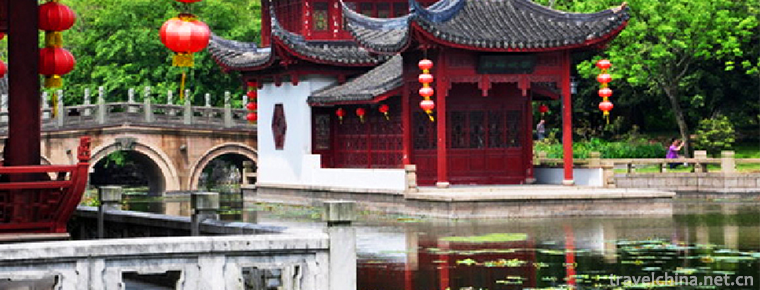
-
taste shrimp
Taste shrimp, also known as spicy crayfish, Changsha taste shrimp, spicy crayfish and so on, is a well-known traditional snack in Hunan Province.
Views: 205 Time 2018-11-14 -
MountHuaguoshan
Mount Huaguoshan (Lianyungang Huaguoshan Scenic Area) is located at the middle foot of Nanyuntai Mountain in Lianyungang City..
Views: 282 Time 2018-12-06 -
Jinan World First Spring Scenic Area
Jinan World No. 1 Spring Scenic Area, located in the center of Jinan City, Shandong Province, is a national AAAAA-level tourist attraction, national key park, advanced unit of national spiritual civil.
Views: 186 Time 2018-12-08 -
China Antique Car Museum
Located on the Houli Cultural Site, the Chinese Ancient Car Museum is the first most systematic and complete Museum in contemporary China, which integrates the Car and Horse Sites with the display of .
Views: 106 Time 2018-12-22 -
Jiangyou Dou Meishan Scenic Area
Dou Meishan Scenic Spot is an important part of Jianmen Shudao National Scenic Spot. It is 25 kilometers north of Jiangyou City and 170 kilometers away from Chengdu.
Views: 153 Time 2019-01-21 -
Shui Guan the Great Wall
Shuiguan Great Wall is the eastern part of Badaling Great Wall. It was built at the mouth of dangerous valley. The Great Wall of Zishuimen Archery Tower is "V" shaped.
Views: 211 Time 2019-02-13 -
Manufacturing Techniques of Tussah Paper
The manufacturing history of tussah paper is as long as that of linen paper. The raw material for making the paper is the phloem fibers of the tree. The bark of the tree contains wood phloem fibers wh.
Views: 181 Time 2019-04-18 -
Pile brocade
Duijin, also known as Shangdang Duijin, is a handicraft hand Duijin is developed on the basis of traditional Chinese painting and embroidery. It is made of silk as the main fabric.
Views: 136 Time 2019-04-28 -
Ocean song
Fisherman's chant is the traditional folk song of Zhoushan Islands in Zhejiang Province, which belongs to the general name of the local boat and fisherman's chant..
Views: 86 Time 2019-05-02 -
Hua gu deng Flower drum lantern
Flower drum lantern, a traditional dance in Bengbu City, Fengtai County and Yingshang County, Anhui Province, is one of the national intangible cultural heritage..
Views: 233 Time 2019-05-04 -
Making Skills of Sheng Xifu Leather Cap
Shengxifu leather cap production skills need to go through the whole process from matching, picking, blowing, brushing, flat leather, shaving, hand needle sewing to machine sewing, and finally complet.
Views: 134 Time 2019-06-14 -
Zhou Cuns Baking Cake Making Skills
Zhou Cun's baking technology has a history of more than 1,800 years. According to Zizhi Tongjian, in the three years since Emperor Heng of Han Dynasty Yanxi, Hucai vendors have been exiled in Shandong.
Views: 289 Time 2019-08-10
